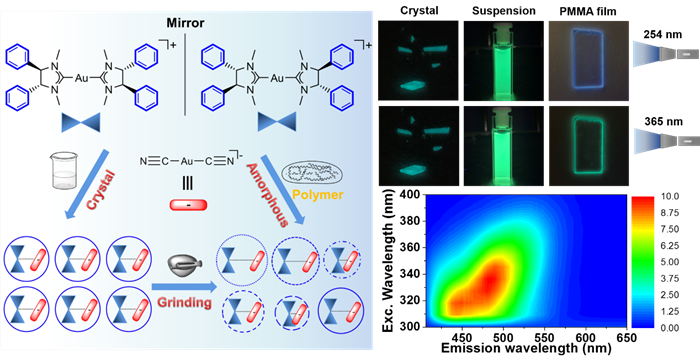[ Instrument Network Instrument R & D ] Dynamic stimulus-responsive materials have broad application prospects in the field of smart materials. Among them, smart wavelength-dependent smart light-emitting materials are easy to operate and non-immersive, which has aroused great interest. Recently, Chen Yong's team and collaborators from the Research Center for Photochemical Conversion and Synthesis of the Institute of Physics and Chemistry of the Chinese Academy of Sciences have reported a class of gold (I) carbene double salt compounds with excitation-wavelength-dependent circularly polarized emission.

Previous research by researchers (Angew. Chem. Int. Ed. 2018, 57, 6279-6283; Chem. Commun. 2018, 54, 12844-12847; Angew. Chem. Int. Ed. 2020, 59, 2080-2984) Based on the introduction of a chiral substituent group on the azacarbene ligand, the gold-gold interaction and Coulomb interaction are changed, and the supramolecular assembly process of the gold (I) carbene double salt is regulated, breaking the long range Ordered gold-gold interactions have obtained thermodynamically stable gold (I) carbene double salt ion pairs (RC-A and SC-A) under crystalline conditions.
In polymers (such as PMMA), these gold (I) carbene double salts aggregate to form a series of metastable species with different gold-gold distances, and then exhibit excitation wavelength-dependent luminescence characteristics. When the excitation wavelength was increased from 300 nm to 400 nm, the maximum emission peak gradually shifted from 440 nm to 530 nm. Due to the presence of chiral substituents, the light emission has obvious circular polarization characteristics. The corresponding isomers RC-A and SC-A exhibit mirror-symmetrical left-handed and right-handed circularly polarized light emission, respectively, and the asymmetry factor values ​​are 1.60. × 10-3 and -1.45 × 10-3. The unique excitation wavelength-dependent circularly polarized light-emitting properties make these materials have potential applications in 3D display, quantum encryption, optical communication, and optical security.
This work introduced circularly polarized light emission in response to the excitation light of a single-component metal complex by introducing a sterically hindered group to regulate the gold-gold interaction, effectively avoided the phase separation problem of the material, and designed a novel stimulus-responsive material. And new concept device applications provide new ideas. The relevant research results were published in the recent "Angewandte Chemie International Edition". The first author of the thesis is Yang Jiangong, a doctoral student at the Institute of Physics and Chemistry, and Li Kai (co-first author), an assistant professor at the School of Materials Science and Technology of Shenzhen University. The corresponding author is Chen Yong. Professor Li Mingde of Shantou University performed femtosecond time-resolved absorption and emission spectroscopy measurements. Dr. Wang Jian from Jilin University and Professor Liu Gang from Singapore University of Science and Technology gave strong support in theoretical calculations. Related research work was supported by the National Natural Science Foundation of China and the Chinese Academy of Sciences-Hong Kong University New Materials Synthesis and Testing Laboratory.
5 Ton Forklift,5 Ton Electric Forklift,All Wheel Drive Forklift,All Terrain Forklift For Sale
Shandong Yineng Heavy Industry Co.,Ltd , https://www.yinengloader.com